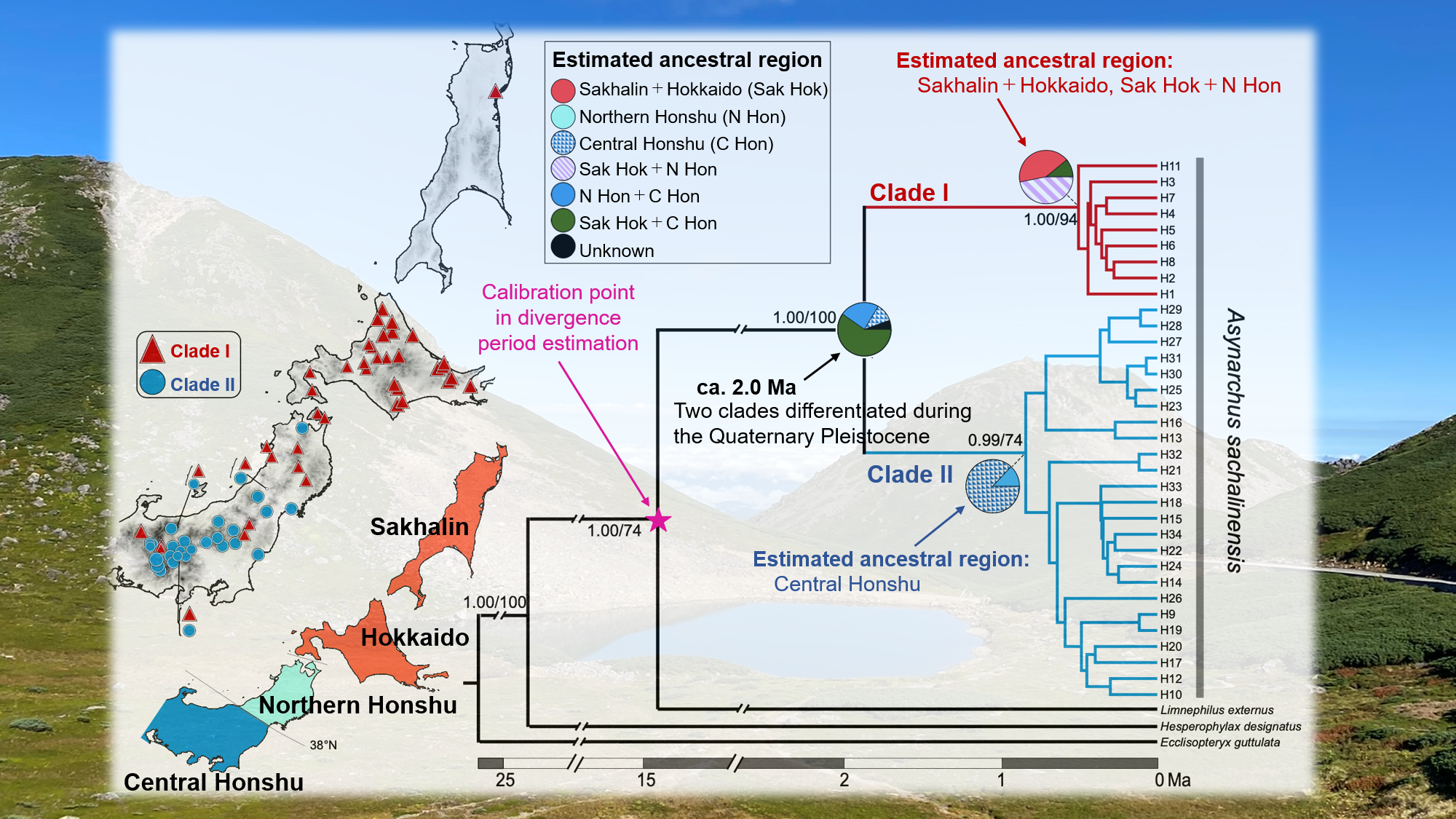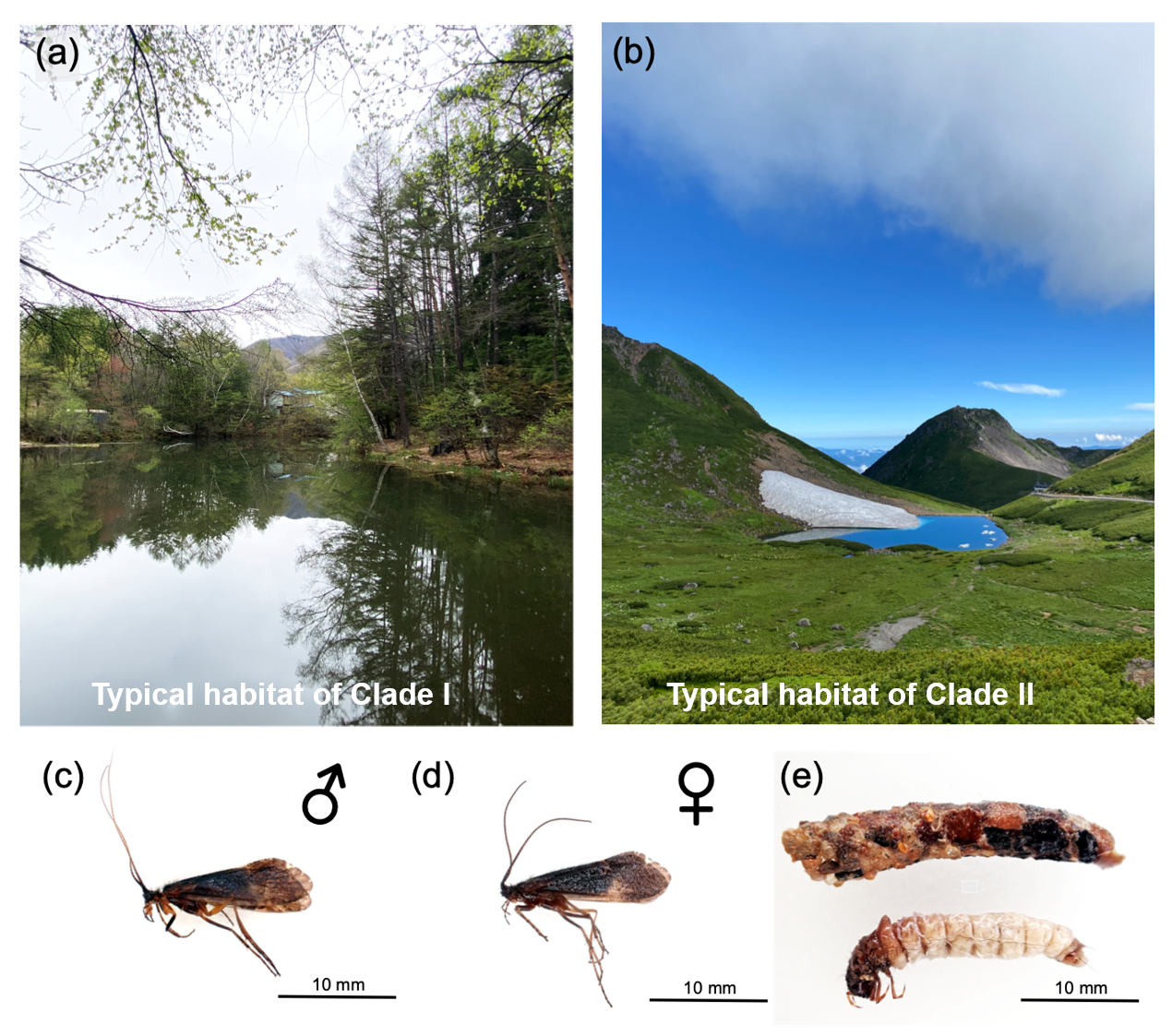Natural Sciences, Social Sciences, and Humanities
Release date:April 24, 2025 1:52 PM
Faculty of ScienceCreating species diversity: Analyzing the genes of organisms present in the harsh environments of alpine zones

Alpine zones, such as the Chubu Mountains, are home to several organisms that have through evolution, adapted to harsh environments such as low temperatures and freezing. Professor Tojo and his team studied the evolutionary process of an aquatic insect known as Asynarchus sachalinensis at the genetic level and revealed that A. sachalinensis split into two groups that could now be considered “separate species,” as the glacial and interglacial periods repeated. The findings of this study indicate that climate changes in the past triggered the birth of a new species and that the environment of the alpine zones has promoted the evolution and diversification of life.
Analyzing the genes of the Asynarchus sachalinensis to explore its evolution and the effects of climate change
Preservation of ecosystems has emerged as one of the most important issues as global warming progresses. Glaciers and snowfields are shrinking rapidly, particularly in mountainous regions. Consequently, endemic organisms that have adapted to harsh environmental conditions such as low temperature, drought, and strong ultraviolet rays are at risk of extinction. Professor Tojo and his team analyzed the past evolutionary process of A. sachalinensis at a genetic level, an aquatic insect present in cool ponds and springs that can survive in cold environments. Furthermore, they also investigated the effects of past climate changes on the range shift of A. sachalinensis, the connectivity and fragmentation of local populations, and the resulting genetic structure.
Asynarchus sachalinensis split into two groups approximately 2 million years ago
A. sachalinensis is a species of caddisflies that is 1–1.5 cm long. A total of 144 specimens of A. sachalinensis were collected from 74 locations from the Chubu-Sangaku Mountain Range to Sakhalin. The base sequence (*2) of their entire genome DNA (*1) were obtained from parts of their walking legs. Analysis of multiple regions of mitochondrial DNA (*3) revealed that A. sachalinensis split into two groups (groups I and II) approximately 2 million years ago. Group I was widely distributed in the relatively lowlands of Hokkaido and Tohoku. Group II was scattered mainly in the alpine zone of central and western Honshu.

Climate change will give rise to new species! High altitudes support species diversification!
Genetic analysis revealed that “during the repeated glacial and interglacial periods, Group I existed at relatively low altitudes, allowing it to move easily and distribute widely, whereas Group II existed at high altitudes, resulting in a scattered distribution in isolated environments.” Furthermore, high-altitude organisms were more likely to acquire unique lifestyles (subject to natural selection) in the harsh and isolated environments unique to high altitudes. Subsequent research has also shown that although populations of both groups are present on Mt. Norikura, differences have been noted between alpine and sub-alpine zones of Mt. Norikura in terms of reproductive timing. An accumulation of genetic mutations has resulted in them coming to form “separate species.” Thus, it has demonstrated how climate change can lead to the birth of new species and that high altitudes, in particular, support species diversification.
Points
Professor Tojo and his team analyzed the evolutionary process of A. sachalinensis at a genetic level, an aquatic insect present in the harsh environments of alpine zones, to determine the influence of climate change on its evolution.
Analysis of mitochondrial DNA revealed that A. sachalinensis split into two groups approximately two million years ago, with Group I being distributed widely in lowlands and Group II being scattered in highlands.
Climate change can give rise to new species; organisms in harsh and isolated alpine zones are particularly susceptible to developing lifestyles that differ from those of the organisms in lowlands .
Keywords
- *1 Whole genomic DNA
Deoxyribonucleic acid (DNA) contains all the genetic information of an organism, including nuclear DNA and mitochondrial DNA. It is the blueprint for living things.
- *2 Nucleotide sequence
DNA comprises four bases: adenine, thymine, guanine, and cytosine. The base sequence refers to the order in which these four bases are arranged, which in turn determines the specific proteins that are synthesized.
- *3 Mitochondrial DNA
Circular DNA is present in the mitochondria within cells. Sequence information of specific regions (e.g., COI and 16S rRNA) is often used for evolutionary phylogenetic analysis of organisms.
Paper
Journal:Ecology and Evolution. 2024; 14:e11428.
Title:Variations in the phenological patterns of a caddisfly inhabiting the same mountain massifs: Life‐history differences in different altitudinal zones.
Author:Hirohisa Suzuki, Masaki Takenaka, Koji Tojo
Related Topics
Related Topics
-

Faculty of Science
Creating species diversity: Analyzing the genes of organisms present in the harsh environments of alpine zones
-

Faculty of Engineering
Impact of binary interactions on the evolution of supernova progenitors
-

Center for General Education
"Dust torus" influences ionization bias in the gas around quasars, providing clues to understanding the formation of stars
-

Faculty of Economics and Law
Discrepancies between risk attitudes and prevention behavior: examination of human decision-making through an economic experiment
-

Faculty of Science
Development of analytical technology for the safe and easy detection of controlled drug toxicants
